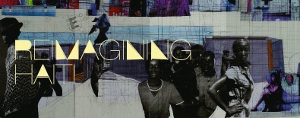RESEARCH - EVENT OR WORK
Questions about Re-Imagining Haiti with Co- Curator Shante Cozier
On the eve of the one-year anniversary of the earthquake that ravaged Haiti in January 2010, this collaborative exhibition offered contemporary work by artists who are examining the spirituality, aesthetics, and re-construction of Haiti. Through an open call, visual, performing and literary artists – as well as musicians and filmmakers – were invited to submit work that is centered on a conceptual rethinking of the cosmological and socio-political conditions in Haiti at the present moment. Over twenty artists were selected to participate in Reimagining Haiti featuring works in painting, photography, video, installation, illustration and mixed media. The exhibition will be on view at Caribbean Cultural Center/African Diaspora Institute (CCCADI) from January 13th to May 8th, 2011 and at Museum of Contemporary African Diasporan Art (MoCADA) from January 20th to May 8th, 2011. Jabari Owens-Bailey sat down with co-curator Shante Cozier to interview her regarding the Exhibition and explore her take on the process of creating such an important and transformative exhibition.
S: Shante Cozier
J: Jabari Owens-Bailey
J: Why is Reimagining Haiti an important exhibition?
S: The exhibition is very important because it marks a year after the earthquake. The first part of the exhibition opened on the 13th of January at Caribbean Cultural Center African Diaspora Institute and the second part on the 20th at MoCADA. The idea of Re-imagining Haiti is important for us because it is one exhibition conceptualized differently in two spaces, and we are dealing with the idea of re-conceptualizing a nation through artwork.
J: Did you have a target audience that you were trying to reach with this exhibition?
S: I think that our audiences are all ages, all races, and all cultures. The mission of the museum is to foster the arts and culture of the African Diaspora. We really aim to educate everyone in this regard.
J: You briefly touched on this, but what is the significance of the dual platform of the exhibition in being at two locations?
S: The Caribbean Cultural Center’s mission is very much aligned with our mission. They are dealing with the African Diaspora in the Caribbean and we are dealing with the African Diaspora at large. Haiti being an Island in the Caribbean we thought this would be an ideal way for us to collaborate. We’ve collaborated on events and programs before, but never an exhibition. We were being really ambitious, but it was ideal for us, as like-minded organizations, to create this exhibition.
J: What types of ideas influenced the artists’ work in the exhibition?
S: I never know exactly what triggers the artists to submit the work that they submit. I imagine all kinds of things could and would inspire them. Some of the artists were inspired by the idea of ‘re-imagining’ Haiti, some by the fact that it was the anniversary of the earthquake, and others were inspired by the looking at Voodou in a contemporary sense. So there are various reasons.
J: So the spiritual component of Haitian life plays a major component in the exhibition?
S: Yes. I wouldn’t say that it outshines any other component of the exhibition, though. Voodou is the religion that the enslaved Africans brought with them when they were taken from Africa. It is the religion that is very much a part of Haitian culture. To create an exhibition called Re-imagining Haiti and not address Voodou would be irresponsible.
J: Do you feel that this exhibition has the potential to play a healing role in the community?
S: That’s a good question. I would say yes. There is a healing piece in the exhibition, the Nkisi, 2010, by Adrienne Wheeler. It is a piece made for the people of Haiti after the earthquake to help heal them. Nkisi are usually medicine bags comprised bundles composed of sacred objects that when combined create a healing energy. I would not say that the intent of the exhibition in its totality is to heal, but there is a soothing, constructive, ideal that permeates the show.
J: Each room seems to have its own theme. Please elaborate on each room.
S: The first room, the purple room, is the spiritual component. It is again dealing with contemporary visualizations of Voodou. The second room is more historical and political. It is both pre and post earthquake. The last room encompasses works that ‘reconstruct’ in a futuristic way.
J: Which artist’s work, if any, encompasses the whole feel and theme of the exhibition?
S: I would say Nathan Williams. And that is why we used his artwork as the signature image of the exhibition. He specifically was inspired by the open call. Even though all the work is dealing with this idea of Reimagining Haiti, he was trying to address it on multiple levels. He used themes from architectural design and applied them to the ideas of ‘building’ community, culture, and nation. This work speaks to the totality of the exhibition.
To access more information and resources relating to Reimagining Haiti including: images of works featured in the exhibition and a video interview with co-curator Shantrelle P. Lewis of CCCADI click here
Contributed by: Jabari Owens-Bailey, Curatorial Fellow
